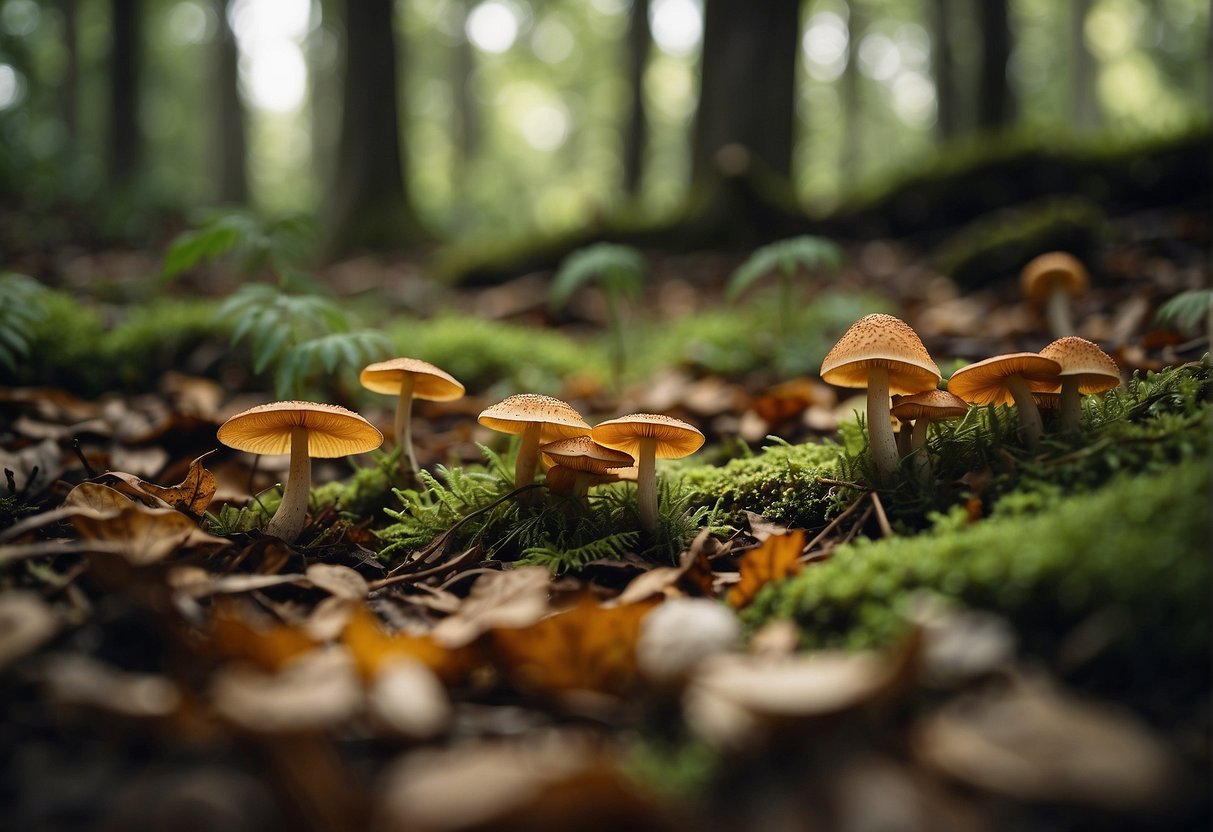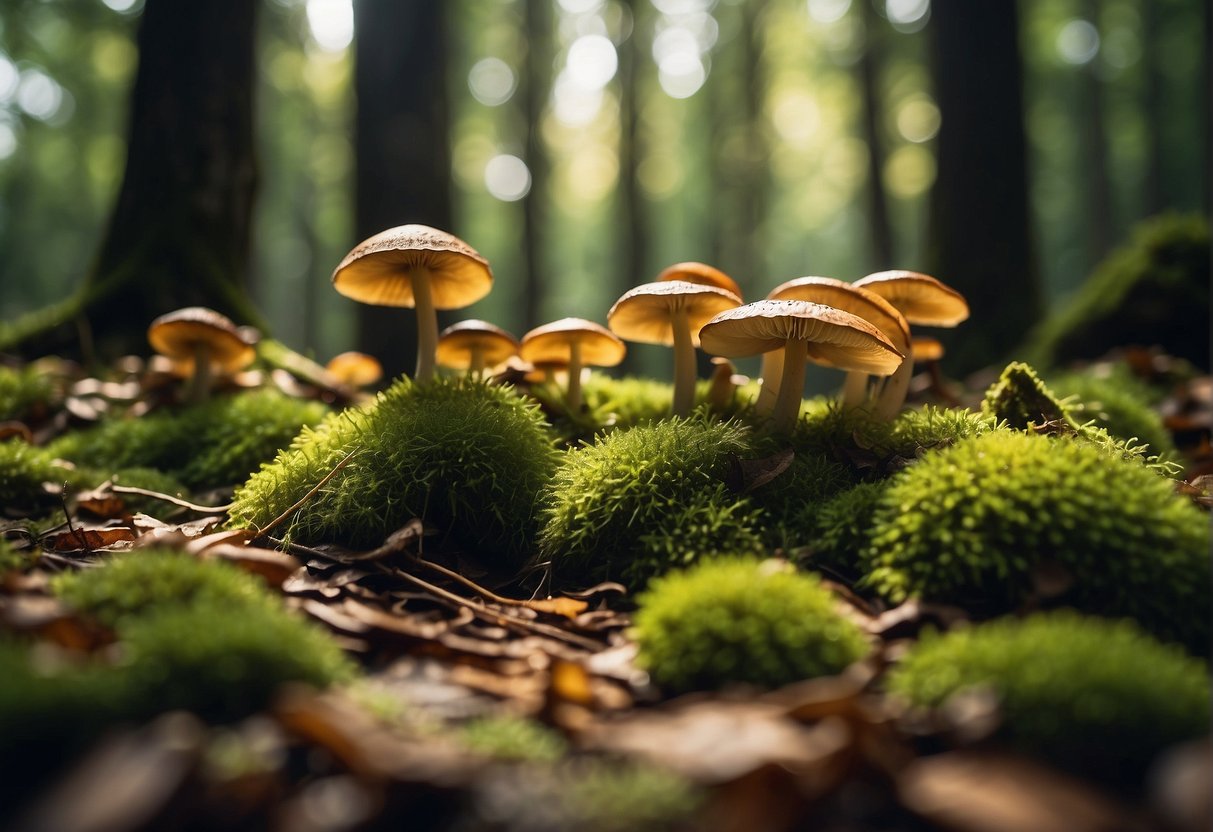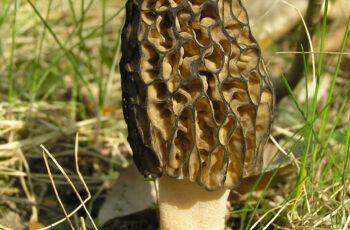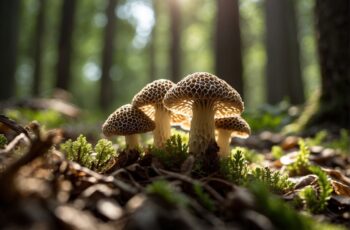Embarking on a mushroom hunting adventure in New Jersey presents a unique blend of fun and exploration. With its varied landscapes, from the dense forests of the Highlands to the sandy soils of the Pine Barrens, the Garden State offers an ample bounty for foragers. It’s a pastime that invites you into the fresh air, connects you with nature, and can even add a delightful, wild-harvested touch to your culinary creations.

When you set out to hunt for mushrooms in New Jersey, you’re not just searching for fungi—you’re immersing yourself in a tradition that spans generations. In these woods and fields, a quiet step and a keen eye might reveal sought-after varieties such as the delicate morels in spring or the robust chicken-of-the-woods in autumn. It’s important to remember, however, that safety and respect for the environment are paramount.
Before you start your journey, make sure you’re familiar with the mushroom foraging laws in New Jersey to ensure your foraging is both legal and sustainable. Proper identification is crucial not just for your safety but also for the preservation of edible species and their ecosystems. With every trek through New Jersey’s natural habitats, you have the opportunity to discover the joys of mushroom hunting while nurturing a deeper appreciation for the intricate web of woodland life.
Getting Started with Mushroom Hunting in New Jersey
Embarking on a mushroom hunting adventure in New Jersey is an exciting endeavor, but it requires a solid understanding of the basics, knowledge of the optimal seasons, and an emphasis on safety during identification and foraging.
Understanding the Basics of Mushroom Hunting
Mushroom hunting, or foraging, is a rewarding outdoor activity that allows you to connect with nature and enjoy the bounty of edible species available across New Jersey’s diverse landscapes. Before you step into the woods, equip yourself with a reliable guide to familiarize yourself with the variety of mushrooms you might encounter. Start by researching edible mushrooms common to the area and be wary of their look-alikes — poisonous mushrooms that can cause severe health issues.
Identifying Prime Mushroom Hunting Seasons
The success of your foraging trip largely depends on timing. In New Jersey, the mushroom season generally begins in spring and can extend through early winter. Morels, coveted for their taste, typically emerge in spring, while species like the Honey Mushroom flourish in the fall. Your best bet is to use a season-specific guide or local experts to find the peak times for different types of mushrooms.
Mushroom Identification and Foraging Safety
Safety should be your top priority when mushroom hunting. Invest in a comprehensive field guide to mushroom identification, and consider downloading apps or printing resources from trusted websites. Always verify the mushrooms you collect, and when in doubt, err on the side of caution and don’t consume them. Protect yourself and the environment by following local foraging laws and regulations. Remember, your safety and the preservation of nature’s balance go hand-in-hand with the enjoyable practice of mushroom foraging.
Popular Mushroom Hunting Locations in New Jersey

New Jersey offers an array of locales ripe for mushroom hunting. These range from state-owned parks and forests to private lands where permissions are necessary. Familiarize yourself with local laws and liaise with organizations such as the New Jersey Mycological Association for guidance.
State Parks and Forests
- State Parks: You’ll find parks like Wharton State Forest in the Pine Barrens region to be a hotspot for diverse fungi, thanks to its sandy soil and unique ecosystem.
- Forests: Northern Highlands and South Jersey woodlands also harbor a rich variety of mushrooms, including edible species favored by foragers.
It’s essential to check for any specific regulations pertaining to mushroom harvesting in these areas to ensure your foraging is lawful and sustainable.
Private Property Access and Regulations
Gaining access to private property may expand your mushroom hunting grounds significantly. However, this often involves:
- Seeking Permission: Always get explicit permission from landowners before foraging on their land.
- Understanding Boundaries: Respect the boundary lines and private property signs to avoid trespassing.
Remember, New Jersey laws and regulations must be observed to maintain the balance of these ecosystems and the continuity of mushroom hunting as a cherished outdoor activity.
Mushroom Species to Look for in New Jersey
New Jersey forests and fields offer a diverse range of mushroom species, from highly sought-after edibles to varieties you should avoid due to toxicity. Familiarize yourself with these species to enrich your mushroom hunting adventures.
Morels and the Hunt for Morchella
Morel Mushrooms (Morchella sp.) are a prize find for any mushroom hunter. These distinctive fungi emerge in the spring, making their home in woodlands and sometimes in burned-over areas, where they may form symbiotic relationships with various tree species. Well-camouflaged against the forest floor with their conical, sponge-like appearance, morels can range from about two to nine inches in height. When searching for morels, it’s important to be cautious, as there are look-alike species which can be poisonous.
Other Edible and Poisonous New Jersey Mushrooms
New Jersey’s woods are rife with both edible and poisonous mushrooms. Notable among the edibles are:
-
Chanterelles (Cantharellus cibarius), often found in mossy forests, recognizable by their yellow to orange color and trumpet-like shape.
-
Chicken-of-the-woods (Laetiporus sp.), a vibrant shelf fungus with a poultry-like taste, typically growing on dead or dying trees.
Additionally, the less common but equally delicious Hen-of-the-woods (Grifola frondosa) awaits the patient forager at the base of oak trees.
Despite the abundance of common edible mushrooms, always exercise caution. Some species can be poisonous and look strikingly similar to their edible counterparts. It is crucial to consult with local experts or reliable guides like A Comprehensive List of Common Wild Mushrooms in New Jersey and never consume a mushroom unless you are entirely certain of its identification.
Joining the Mushroom Hunting Community
Mushroom hunting can be a rewarding outdoor activity, especially in the diverse ecosystems of New Jersey. Joining a community can enhance your experience, providing you with valuable knowledge and connecting you with experienced mycologists.
New Jersey Mycological Association and Other Groups
New Jersey Mycological Association (NJMA) is your go-to organization for everything fungi. Established by enthusiasts, the NJMA encourages mushroom appreciation and educates the public about the benefits and risks of mushroom foraging. By joining the NJMA, you’re stepping into a friendly community that offers regular forays into New Jersey’s forests, guided by knowledgeable experts. The association also hosts meetings, lectures, and events where you can connect with fellow mushroom hunters.
- Find NJMA online: njmyco.org
- Annual Membership: Includes access to forays and educational events
Educational Resources and Local Forays
Arm yourself with knowledge through guidebooks and local forays before you head out into the wild. New Jersey’s mushroom scene is vibrant and varied, with fungi ranging from the delectable morel to the elusive chanterelle. Educational resources provided by mycological societies like the NJMA or online platforms will help you identify native mushrooms and understand their habitats.
- Educational resources to consider:
- Guidebooks specific to mushrooms in New Jersey
- Workshops conducted by experienced mycologists
- Local forays:
- Sign up for guided tours to learn the art of mushroom hunting
- Hands-on experience in identifying and harvesting mushrooms safely
By indulging in these community resources, you’re setting yourself up for successful and enjoyable mushroom hunting adventures.


